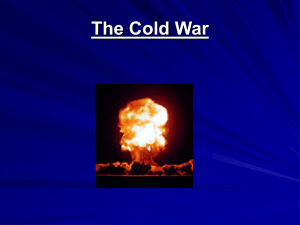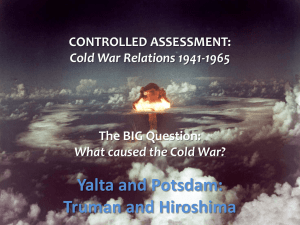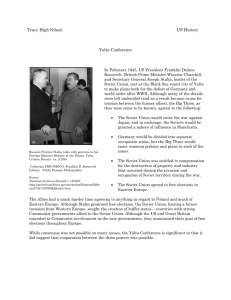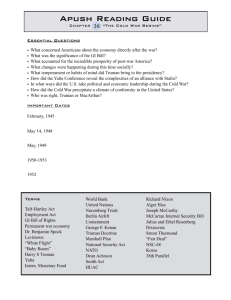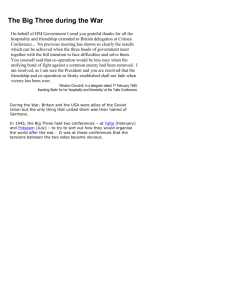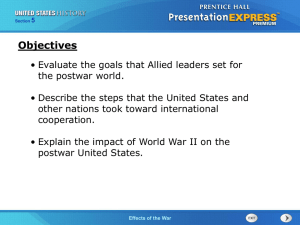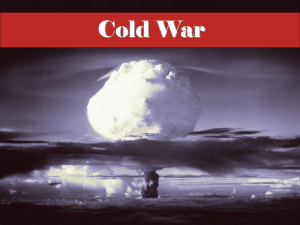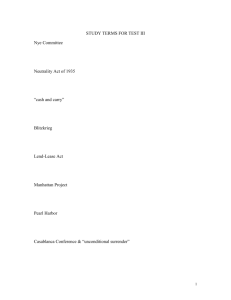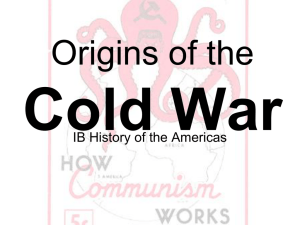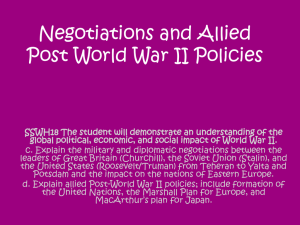Step 3: Synthesis à In the context of the era of WWII conferences à
advertisement
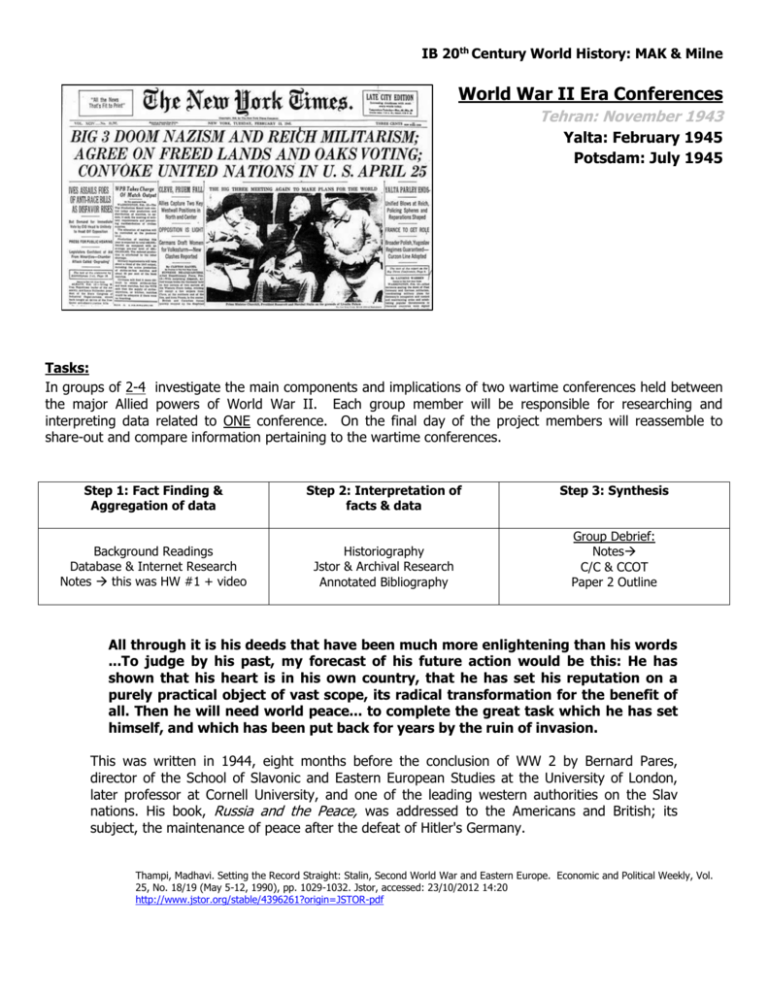
IB 20th Century World History: MAK & Milne World War II Era Conferences Tehran: November 1943 Yalta: February 1945 Potsdam: July 1945 Tasks: In groups of 2-4 investigate the main components and implications of two wartime conferences held between the major Allied powers of World War II. Each group member will be responsible for researching and interpreting data related to ONE conference. On the final day of the project members will reassemble to share-out and compare information pertaining to the wartime conferences. Step 1: Fact Finding & Aggregation of data Step 2: Interpretation of facts & data Background Readings Database & Internet Research Notes this was HW #1 + video Historiography Jstor & Archival Research Annotated Bibliography Step 3: Synthesis Group Debrief: Notes C/C & CCOT Paper 2 Outline All through it is his deeds that have been much more enlightening than his words ...To judge by his past, my forecast of his future action would be this: He has shown that his heart is in his own country, that he has set his reputation on a purely practical object of vast scope, its radical transformation for the benefit of all. Then he will need world peace... to complete the great task which he has set himself, and which has been put back for years by the ruin of invasion. This was written in 1944, eight months before the conclusion of WW 2 by Bernard Pares, director of the School of Slavonic and Eastern European Studies at the University of London, later professor at Cornell University, and one of the leading western authorities on the Slav nations. His book, Russia and the Peace, was addressed to the Americans and British; its subject, the maintenance of peace after the defeat of Hitler's Germany. Thampi, Madhavi. Setting the Record Straight: Stalin, Second World War and Eastern Europe. Economic and Political Weekly, Vol. 25, No. 18/19 (May 5-12, 1990), pp. 1029-1032. Jstor, accessed: 23/10/2012 14:20 http://www.jstor.org/stable/4396261?origin=JSTOR-pdf Conference Specific Research: Tehran, Yalta or Potsdam Step 1: Fact Finding & Aggregation of data Background Readings: Tignor et. al: The Three-World Order, 1940-1975 Todd: Cold War History for IB (Cambridge) Keeley et. al: Cold War History for IB (Pearson) Lisa King (see in packet) Identify: Significance of Location Participants: Goals, Ideological differences Conflict/Rivalry Diplomacy Agreements or Concessions Decisions/Results Short vs. long term consequences Step 2: Interpretation of facts & data Incorporating Historiography Share out in groups: Address the following questions using evidence from research: Significance of Location Participants: Goals, Ideological differences Conflict/Rivalry Diplomacy Agreements or Concessions Decisions/Results Short vs. long term consequences Add historical perspectives to prepare for synthesis questions and discussion In General: Western Liberal (US & Brits) Soviet Orthodox Marxist Revisionist Identify at least 2 key figures in regards to the historiography of the conferences May be WWII era contemporary accounts (see NY Times archives) May be mid-late 20th or 21st century accounts On the Computer/Internet: **Begin with Gale PowerSearch** (HHS Library Databases) Suggested Databases: --Global Issues in Context --Opposing Viewpoints in Context --World History in Context --Modern World History Online --ProQuest --Questia --AP Source Step 3: Synthesis Using Jstor: -Research academic journals (use “advanced search” function to search by multiple key terms and narrow search results) --Identify historians and perspectives on the main components and implications of the conference(s) --Categorize and assess the interpretations by school (Orthodox vs. revisionist, Soviet vs. Western) In addition, be sure to address: Competing ideologies Territorial decisions Collective Security Political Repercussions For what reasons, and with what results, were there disagreements between participants at the conference(s)? Compare and contrast the roles of Truman and Stalin. “An unnatural alliance that was bound to fall apart after the defeat of the common enemy.” To what extent does this statement explain the developments of the conference? To what extent did events in the final year of the Second World War turn wartime allies into Cold War enemies? How, and to what extent, did the conferences contribute to the origin of the Cold War? Notes: It may be advantageous to organize information in chart form… Ex. Goals… Conflict… Source (U Chicago citation) Fact, Fact, Fact… Fact, Fact, Fact… Source (U Chicago citation) Fact, Fact, Fact… Fact, Fact, Fact… Keep track of sources using University of Chicago Style AND an ANNOTATED BIBLIOGRAPHY Annotated Bibliography: --A brief summary of the information the source provides. (1-2 sentence) --A brief evaluation of the source (1-2 sentences) --A statement about the source’s importance to your research (1-2 sentences) Compare/Contrast the Three Conferences Explain how the Grand Alliance Changed Over Time Paper 2 Outline: To what extent was Stalin successful at meeting his aims at Tehran, Yalta and Potsdam? THE RESEARCH PROCESS: Preliminary Reading: general reference material, like an encyclopedia, dictionary, or other reference book Subject Specific Reading: look up material on your subject by using the library catalogue and consulting sources listed in the general reference material Tips: -Read through the bibliographies and notes of everything you read for further sources -Consult periodical indexes for articles on your subject Notes: -Organize notes into logical groups -You may notice a gap in your research, or a more heavy weighting to one aspect of the subject than what you had intended Types of Notes: (Set up a word document to cut and paste bibliographic information & quotes, statistics….) Data Sheet Source 1. 2. 3. Facts & Quotes 1. 2. 3. Fact Finder Sheet What I already know 1. 2. 3. Key Words & Search Terms 1. 2. 3. Facts that I have found A. B. C. Key Words & Search Terms 1. 2. 3. Clustering or Mapping SubTopic Evidence -Subtopic heading Evidence -One main point per card -Write only essential words, abbreviate when possible (data, statistics, quotes) Topic / Questio n SubTopic Note Cards -Identify direct quotes with quotation marks and the person's name Evidence -Include source information Evidence The Following questions may help you write your annotation: Summarize: What are the main arguments? What is the point of this book or article? What topics are covered? If someone asked what this article/book is about, what would you say? Evaluate: Is the information reliable, accurate, and or authoritative? Is this source biased or objective? What is the purpose or goal of this source? What is the OPVL of the source? Reflect: Was this source helpful to you? How does it help you answer or expand your questions and shape your argument? How can you use this source in your research project? Has it changed how you think about your topic? Background: Matters of postwar policy were discussed at diplomatic meetings during the course of the war, specific policies were not thoroughly discussed in order to avoid a rupture in the alliance. Prime Minister Winston Churchill and Premier Josef Stalin had made an informal agreement at the Second Moscow Conference, October 1944, that would divide the Balkans into British and Russian spheres of influence after the war. Roosevelt was not a party to this agreement and soon let it be known that he would not be bound by the decision reached at the Moscow Conference. The issue of Poland appeared to be the breaking point of the grand alliance. Roosevelt and Churchill acquiesced to most of Stalin’s demands at Yalta in exchange for a Russian pledge to enter the war against Japan shortly after the war in Europe was brought to a close. Churchill and Roosevelt did get Stalin to agree to “free and unfettered elections” in Poland and Eastern Europe based on universal suffrage and secret ballot. A few months later at Potsdam, the Polish issue and Soviet interest in Eastern Europe were to again be the focal points of discussion. Truman had become President in April following Roosevelt’s death and Churchill, who attended the first sessions of the conference, was defeated in the British election and was succeeded by Clement Attlee. Roosevelt’s death in April 1945 was cause for alarm in the Soviet Union. Roosevelt’s vice president was virtually unknown to the Russians; however, they were aware that when German armies invaded Russia in June 1941, then Senator Truman was quoted in the press as having said, “If we see Germany is winning we ought to help Russia and if Russia is winning we ought to help Germany and that way let them kill as many as possible. . . .” In April, Soviet Foreign Minister V. M. Molotov met with Truman at the White House before traveling to San Francisco for the United Nations Conference. Truman was reported to have given Molotov a tonguelashing and Molotov stormed out of the meeting. Hostility between the U.S. and Soviet Union intensified during the San Francisco conference. It appeared to the Russians that the U.S. was determined to form a bloc of anti-Soviet nations. U.S. insistence of the admission of Argentina, a nation that had strong German ties during the war, confirmed Soviet suspicions. In May, Truman and his cabinet adopted a policy of abruptly ending the lend-lease program to Russia, criticized the Soviets for taking over the Eastern European countries, and condemned them for removing German factories to Russia to replace some destroyed in the war. The Soviets were suspicious of Truman’s request to postpone the Potsdam meeting that had been originally scheduled for June. Stalin and Molotov were convinced that Truman wanted a delay in order to test the atomic bomb before attending the Big Three conference. Soviet spies operating in the United States had passed on information regarding the Manhattan Project and were aware of work on the atom bomb. It therefore, came as no big surprise, when Truman informed Stalin that the U.S. had a secret weapon of great destructive power. Molotov expressed the Soviet view after the war when he remarked that, “The bombs dropped on Japan were not aimed at Japan but rather at the Soviet Union.” Secretary of State Byrnes was among Truman’s advisors who wanted Truman to adopt a “get tough” policy. Two members of the American delegation at Potsdam, Secretary of War Henry Stimson and former ambassador to Moscow Joe Davies, expressed concern that Byrnes was brandishing the bomb in order to get the Soviets to fall in line. Truman’s altercation with Molotov, the San Francisco Conference, and confrontations at Potsdam over Poland, peace treaties with Axis powers, and German reparations all seemed to confirm that the U.S. had embarked on a new policy in dealing with the Russians. Given the evident enthusiasm of Americans for a war of ideology, Stalin enthusiastically declared one openly on February 9, 1946, by asserting in a speech that the contradictions of capitalism would tear the capitalists countries apart and implied that future wars were inevitable until communism was triumphant over capitalism. The major response by Americans to Stalin’s posture was to “contain” what was regarded as a worldwide conspiracy to spread communism. On February 22, 1946, George Kennan, the American chargé d’affaires in Moscow, sent a confidential cable to the State Department. In this so-called “Long Telegram” Kennan outlined Soviet policy and concluded that the USSR was on a fanatical crusade to obliterate the West. Secretary of the Navy James Forrestal had the Long Telegram reproduced and made it required reading for higher officers in the armed services. In his Memoirs published in 1967, Kennan remarked that the telegram read “like one of those primers put out by alarmed congressional committees or by the Daughters of the American Revolution, designed to arouse the citizenry to the dangers of the Communist conspiracy.” In March, Churchill’s “Iron Curtain” speech solidified opposition to Soviet encroachments in Europe. In 1947, Greece was convulsed by a civil war supported by neighboring Communist states. At the same time the Soviet Union, to secure its position in the Eastern Mediterranean, was putting pressure on Turkey. Faced with what was perceived as a Soviet takeover of both Greece and Turkey, President Truman announced his “Truman Doctrine” that the United States was pledged to preventing such takeovers, and the first of several similar interventions was launched there at a cost of several hundred million dollars. In April 1948, the Marshall Plan to reconstruct Europe was also conceived as primarily an “anticommunist” measure to insure the rapid recovery of European economies devastated by the war. By 1949, the Russians had tested a nuclear bomb. The arms race was on and would continue for nearly half a century. King, Lisa. The Origins of the Cold War, National Center for History in the Schools, University of California, Los Angeles Name: __________________ Your Notes and Annotated Bibliography Information Data Sheet Suggestions Source 1. 2. 3. Facts & Quotes 1. 2. 3. Annotated Bibliography: --A brief summary of the information the source provides. (1-2 sentence) --A brief evaluation of the source (1-2 sentences) --A statement about the source’s importance to your research (1-2 sentences) Your Name: Yalta Group Members: ____________________________________ Potsdam Group Members: _________________________________ Step 3: Synthesis Debrief: Compile Group Notes Yalta and Potsdam: Diplomatic Precursors to the Cold War Yalta: February 1945 Significance of Location Participants: Goals, Ideological differences Conflict/Rivalry vs. Diplomacy Agreements or Concessions… Decisions/Results Short vs. long term consequences Potsdam: July-August 1945 Step 3: Synthesis Compare/Contrast and Change Over Time (as a group) Yalta and Potsdam: Diplomatic Precursors to the Cold War Compare (Contrast) the Results of Yalta & Potsdam Conferences CCOT Explain how the relationship of the Grand Alliance changed over time. What stayed the same? Step 3: Synthesis Historians’ Questions: Based on historiographic research – address the following Yalta and Potsdam: Diplomatic Precursors to the Cold War Yalta: February 1945 For what reasons, and with what results, were there disagreements between participants at the conference(s)? Compare and contrast the roles of FDR and/or Truman and Stalin To what extent did events in the final years of the Second World War turn wartime allies into Cold War enemies? How, and to what extent, did the conferences contribute to the origin of the Cold War? Potsdam: July 1945 Step 3: Synthesis In the context of the era of WWII conferences Outline the following Paper 2 Question: To what extent was Stalin successful at meeting his aims at Yalta and Potsdam?
